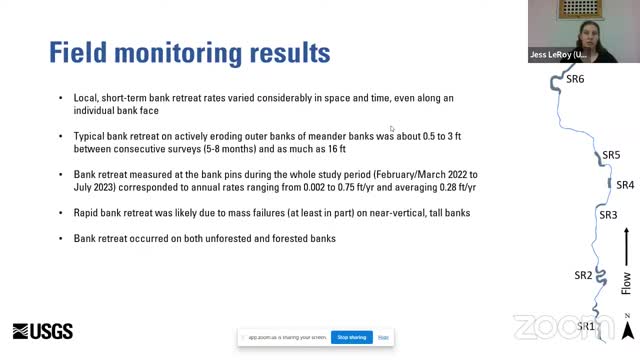Climate change fuels alarming riverbank erosion rates
September 30, 2024 | Wildwood, St. Louis County, Missouri
This article was created by AI summarizing key points discussed. AI makes mistakes, so for full details and context, please refer to the video of the full meeting. Please report any errors so we can fix them. Report an error »

In a recent government meeting, experts presented findings on riverbank erosion and its implications for climate change, revealing significant insights into the dynamics of bank stability and erosion rates. The study focused on a specific area known as the triple meander, where bank retreat reached alarming rates of up to 16 feet, primarily due to a combination of fluvial erosion and mass failure processes.
The analysis utilized bank pin measurements and aerial photographs to assess erosion rates, which averaged about 0.3 feet per year. Notably, the study highlighted that rapid bank retreat was often associated with tall, steep banks lacking stabilizing vegetation. Engineered bank protections, such as riprap, yielded mixed results, proving least effective in areas where banks were steep and un-vegetated.
The researchers also explored the impact of climate change on river dynamics, predicting increases in rainfall and flow rates by 2050 and 2099. These changes are expected to elevate peak flows and total runoff volumes, with velocity and shear stress increasing by up to 12% and 20%, respectively, under future climate scenarios. The findings indicated that areas already experiencing high velocity and shear stress would see the most significant increases.
A key takeaway from the study was the potential of adding storage to mitigate the effects of climate change. Scenarios incorporating additional reservoirs showed substantial decreases in peak flow and shear stress, effectively countering the predicted impacts of climate change. However, the effectiveness of this storage diminished downstream, particularly for larger storms, which tend to fill reservoirs quickly.
The study concluded that while hydrologic modeling provides valuable insights into flow dynamics, it does not fully account for the factors influencing bank stability and erosion. The researchers emphasized the importance of understanding mass failure processes and the resistance to erosion to develop comprehensive strategies for managing riverbank stability in the face of climate change.
The analysis utilized bank pin measurements and aerial photographs to assess erosion rates, which averaged about 0.3 feet per year. Notably, the study highlighted that rapid bank retreat was often associated with tall, steep banks lacking stabilizing vegetation. Engineered bank protections, such as riprap, yielded mixed results, proving least effective in areas where banks were steep and un-vegetated.
The researchers also explored the impact of climate change on river dynamics, predicting increases in rainfall and flow rates by 2050 and 2099. These changes are expected to elevate peak flows and total runoff volumes, with velocity and shear stress increasing by up to 12% and 20%, respectively, under future climate scenarios. The findings indicated that areas already experiencing high velocity and shear stress would see the most significant increases.
A key takeaway from the study was the potential of adding storage to mitigate the effects of climate change. Scenarios incorporating additional reservoirs showed substantial decreases in peak flow and shear stress, effectively countering the predicted impacts of climate change. However, the effectiveness of this storage diminished downstream, particularly for larger storms, which tend to fill reservoirs quickly.
The study concluded that while hydrologic modeling provides valuable insights into flow dynamics, it does not fully account for the factors influencing bank stability and erosion. The researchers emphasized the importance of understanding mass failure processes and the resistance to erosion to develop comprehensive strategies for managing riverbank stability in the face of climate change.
View full meeting
This article is based on a recent meeting—watch the full video and explore the complete transcript for deeper insights into the discussion.
View full meeting
